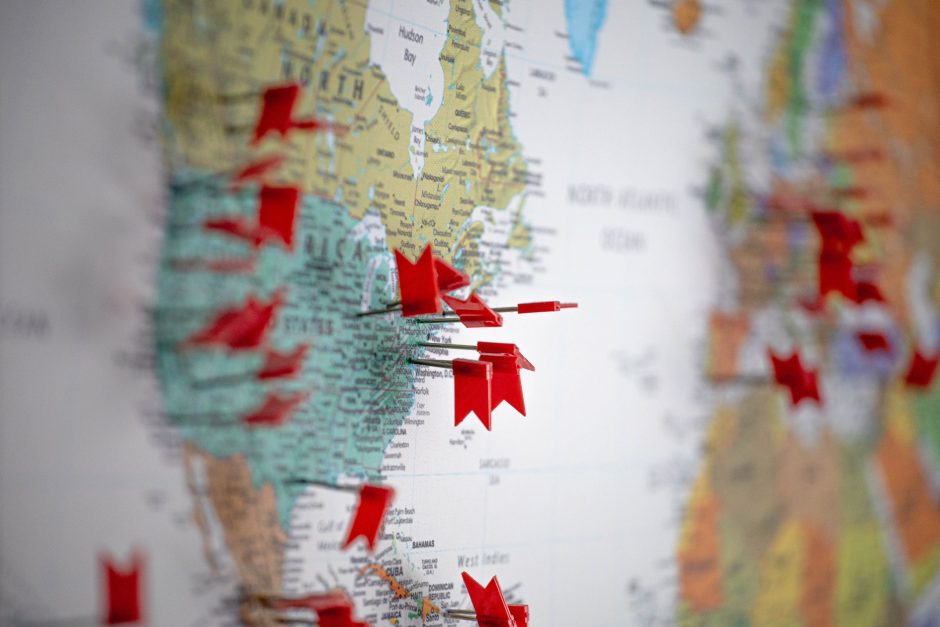Das Nähe Mapping – warum es für Vertrauen und Neukundengewinnung wichtig ist zu zeigen, wo Du tätig bist
Wem vertraust Du mehr, dem Schuster aus Deinem Viertel oder in einem anderen Ortsteil? Suchst Du nur noch über Google nach Dienstleistern oder fragst Du Bekannte? Und zu wem nimmst Du eher Kontakt auf: Zum Handwerker aus Deinem Ort oder dem, der 50 km entfernt ist? Oder dem Software-Hersteller aus Deinem Land oder vom anderen Ende der Welt?
Nähe schafft Vertrauen. Und Nähe ermöglicht den einfacheren Zugang. Neben den Haupt-Content Marketing Methoden, wie SEO Content und Social Media Content, für die Kommunikation von Vertrauen, wie beispielsweise der Kompetenz oder den Resultaten, ist die Nähe ein kleinerer, aber wichtiger Faktor, den Du nicht unterschätzen solltest. Dies gilt für alle Branchen und alle Unternehmen.
Selbstverständlich wirst Du über Google My Business dafür sorgen, dass Dein Unternehmen lokal gefunden wird. Man spricht hierbei auch von lokaler Suchmaschinenoptimierung. Auch hierbei gibt es einiges zu beachten, damit Dein Unternehmen so weit vorne gelistet wird, dass es auch direkt gefunden wird. Dies besprichst Du am besten mit Deiner SEO Agentur oder jemandem, der sich mit Suchmaschinenoptimierung auskennt. Da die allermeisten Unternehmen aber nicht nur lokal tätig sein möchten, geht es mir in diesem Artikel darum herauszuarbeiten, was Du tun kannst, um zu zeigen, wo Du überall Kunden ansprechen möchtest.
In meiner Digitalagentur habe ich häufig damit zu tun gehabt, dass internationale Unternehmen uns gesagt haben, in welchen Ländern sie tätig sind. Sei es mit einer eigenen Niederlassung oder über Handelsvertreter und Partner. Die Standardmethode damit umzugehen ist, dass man die Website in mehreren Sprachen anlegt und unter Kontakt die Adressen angibt. Doch dies ist nicht optimal. Es ist nicht einmal ausreichend, um potenzielle Kunden zielgerichtet anzusprechen. Ich komme etwas später zu der Lösung, die ich stattdessen empfehle.
Ähnliches lässt sich auf ganz viele Unternehmen übertragen. Ich war neulich in der Reinigung, um meine Hemden abzuholen. Die Inhaberin erzählte mir, dass es Kunden gibt, die vom anderen Ende der Stadt zu ihr kommen, weil sie den Service und die gute Leistung schätzen. Zudem bietet sie einen Bringservice an, der die fertige Wäsche ausliefert. Um es ehrlich zu sagen: Ich wäre spontan nicht auf die Idee gekommen, so weit entfernt nach einer Reinigung zu schauen. Aber wenn die Leistung überzeugend ist? Und vor allen Dingen: Wenn die Leistung für mich vor Ort durch den Bringservice verfügbar wird? Warum eigentlich nicht. Wichtig ist nur, dass ein solcher Anbieter auf seiner Website glasklar aufzeigt, wo er tätig ist.
Und noch ein drittes Beispiel: Ein befreundeter Garten- und Landschaftsbauer kam auf mich zu und fragte mich, wie er es hinbekommt, dass er im weiteren Umkreis mehr Neukundenkontakte bekommt. Er ist sowieso schon in einem Umkreis von rund 100 km um seinen Hauptstandort herum tätig. Die größeren und interessanteren Projekte kommen häufig über Empfehlungen. Nur sehr selten wird er von potenziellen Auftraggebern angesprochen, die mehr als 25 km von seinem Standort entfernt sind. Es half auch nichts, Google Anzeigen in diesen Regionen zu schalten. Die Interessenten waren beim Anblick der Website schlicht davon ausgegangen, dass er in ihrer Region nicht tätig ist.
Wie lässt sich diese Situation auflösen?
Dem potenziellen Kunden muss beim Anblick der Homepage unmittelbar klar werden, dass das Unternehmen in seinem Land, in seiner Region, seiner Stadt oder seinem Viertel tätig ist. Ich nenne die Methode dafür: Das Nähe Mapping.
Grundsätzlich gibt es vier Bausteine, die dafür in Frage kommen:
- Einzelne Seiten
- Landkarte
- Symbole, wie beispielsweise Flaggen
- Bild & Text
- Einzelne Seiten
International tätige Unternehmen bieten in der Regel eine englischsprachige Version der Website an. Was ist aber, wenn das Unternehmen in den USA und Australien vor Ort tätig ist und nicht in England und Südafrika (wie ich es vor kurzem bei einem Hersteller medizinischer Geräte erlebt habe)? Dem potenziellen Kunden in Australien erschließt sich auf der Homepage nicht spontan, dass das deutsche Unternehmen vor Ort aktiv ist. Daher empfehle ich: Länder- statt Sprachversionen und für jedes Land eine eigene Seite.
Die einzelnen Homepages werden über Geotagging automatisch aufgerufen, wenn ein User aus diesem Land die URL eingibt oder auf einen Link klickt. Damit ist sichergestellt, dass der Kunde aus Australien direkt auf „seine“ Homepage des Unternehmens kommt. Auf dieser Seite sieht er direkt im Header mindestens die Kontaktdaten in Australien, natürlich mit der Telefonnummer in Australien. Je nachdem, wie das Unternehmen aufgestellt ist, kann diese auch irgendwo anders in der Welt abgenommen werden. Dafür gibt es diverse Services, die solche Lösungen anbieten. Wir haben auch schon Varianten umgesetzt, bei denen im Header direkt die Niederlassung vor Ort im Bild sichtbar war plus ein Bild der wichtigsten Ansprechperson und seinen Kontaktdaten.
Klingt aufwändig? Ist es aber nicht. Moderne Content Management Systeme erlauben die Referenzierung von Inhalten. Das bedeutet, dass die einzelnen Länderversionen nur einmal angelegt werden und nur die individuellen Inhalte dort gepflegt werden. Alle anderen Inhalte werden auf einer englischen Basisversion, zum Beispiel der amerikanischen Seite, gepflegt und von dort automatisch auf allen anderen englischsprachigen Länderseiten ausgespielt.
Der potenzielle Neukunde in Australien (oder Südafrika, oder Singapur, oder …) versteht so unmittelbar, dass das Unternehmen für ihn vor Ort da ist – ein unschätzbarer Vorteil gegenüber einem anderen anonymen Unternehmen auf der anderen Seite der Welt.
Idealerweise wird dies noch kombiniert mit Resultaten im betreffenden Land. Wenn unser besagter Neukunde gleich auf der Homepage noch Referenzen und Kundenstatements aus Australien sieht, ist die Wahrscheinlichkeit, dass er zu diesem Unternehmen Kontakt aufnimmt, um ein vielfaches höher, als wenn er nur eine normale englische Homepage gesehen hätte.
Die gleiche Lösung haben wir für den Garten- und Landschaftsbau-Unternehmer umgesetzt. Jeweils eine eigene Seite für jede größere Stadt im Zielgebiet ist auch für die Suchmaschinenoptimierung ein wunderbares Instrument. Viele User suchen nach der Kombination aus gewünschter Tätigkeit und Ortsnamen. Wenn sie dann die entsprechende Seite in Google finden und auf der Zielseite lesen, dass der Unternehmer dort tätig ist, kombiniert mit 2-3 Fallbeispielen aus der Region, nehmen sie auch gerne Kontakt auf. Selbst wenn das Unternehmen so weit entfernt ist, dass sie es normalerweise nicht in die engere Auswahl genommen hätten.
2. Landkarte
Die gute alte Landkarte wird heutzutage bei den meisten Unternehmen als Google Map integriert. Es gibt ein paar alternative Anbieter und eine Open Source-Lösung. Manche Unternehmen setzen auf Eigenkreationen, was auch nicht schlecht sein muss. Google bringt allerdings einige Mehrwerte mit, wie den Routenplaner und die Zoommöglichkeiten, die diese Variante klar zur meistgenutzten Lösung machen. Wie kann ich nun mit dieser Map zeigen, wo ich tätig bin?
Bei Google Maps sind die Möglichkeiten leider begrenzt. Ich kann einzelne Städte markieren und dort direkt die Kontaktdaten anzeigen. Grundsätzlich besteht auch die Möglichkeit Länder zu markieren. Dies ist jedoch schon deutlich aufwändiger umzusetzen und für viele daher nicht verfügbar. Auch Markierungen von Umkreisen oder gar frei gewählten Bereichen sind so gut wie nicht möglich.
Wer also Stadtteile angeben möchte oder zeigen will, dass er im Umkreis von 100 km tätig ist, kann nur auf eigengestaltete Karten oder Text & Bild zurückgreifen.
3. Symbole
Flaggen auf Websites sind etwas aus der Mode gekommen. Die meisten haben auch nicht schön ausgesehen. Da viele Unternehmen Sprachversionen anbieten, geht das Problem bei Flaggen ja schon damit los, dass man für die englische Version nicht weiß, ob man die amerikanische oder UK-Flagge benutzen sollte. Nichts desto trotz sind sie ein geeignetes Symbol für die angesprochenen Länderversionen. Ich halte eine Ländermarkierung inklusive kleinen, schön gestalteten Flaggen für ein gutes Instrument, um die Zuordnung für den User leicht und schnell möglich zu machen.
4. Bild & Text
Ohne Zweifel die einfachste Möglichkeit, um zu zeigen, wo man tätig ist, ist die Aufzählung der Gebiete in simpler Textform. Gerade für Kleinunternehmen, die in Regionen oder Stadtteilen ihre Dienste anbieten, ist dies die einfachste und effektivste Form. Eine kleine Aufzählung der jeweiligen Gebiete oberhalb oder im Footer der Website kann wahre Wunder bewirken.
Die hier gezeigten Optionen sind einfach umzusetzen und habe große Wirkung auf Neukunden, die nicht direkt am Hauptsitz des Unternehmens sind. Lass Dir das nicht entgehen!



